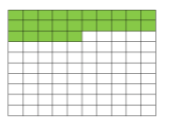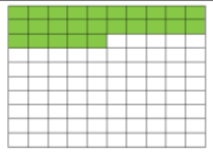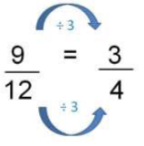| Term |
Description |
Example |
| Decimal Fraction |
A decimal fraction is similar to a fraction. It represents part of a whole.
Just like in whole numbers, each digit in a decimal fraction has its own value. The position of a digit tells us its value. Decimal fractions sit between whole numbers on a number line. |
In the number 8∙234, the 2 has a value of 2/10 (2 tenths)
In the number 8∙324, the 2 has a value of 2/100 (2 hundredths)
In the number 8∙342, the 2 has a value of 2/1000 (2 thousandths)

|
| Decimal Point |
A decimal point separates the whole numbers from the parts in a decimal fraction. |
Twenty-five hundredths (25/100) of the rectangle is green

We write 0∙25.
We say zero point two five. |
| Factor |
A number is a factor if it divides exactly into a number without leaving a remainder.
Factors shared by more than one number are known as common factors. |
The factors of 12 are: 1, 2, 3, 4, 6 and 12.
The factors of 30 are: 1, 2, 3, 5, 6, 10, 15 and 30.
So the common factors of 12 and 30 are: 1, 2, 3 and 6 . |
| Multiple |
A multiple is the result of multiplying a number by a whole or negative number. For example, 15 is a multiple of 5 and 3 because
5 x 3 = 15
16 is not a multiple of 5 as no number can be multiplied by 5 to give 16. Being able to skip count in multiples is useful when multiplying, e.g. 4, 8, 12, 16, 20….. A number that is common to two or more numbers is known as a common multiple. |
Some multiples of 2 are: 2, 4, 6, 8, 10, 12, 14, 16, 18 …
Some multiples of 3 are: 3, 6, 9, 12, 15, 18 …
So, some common multiples of 2 and 3 are 6, 12 and 18.
Talk to your child about the patterns that he or she notices |
| Negative Number |
Negative numbers are whole numbers below zero.
Negative numbers are usually written with a minus sign in front. |
-5 means minus five or negative five.
Talk with your child about where and how negative numbers are used in daily life. |
| Percentage |
Percent means parts per 100.
When writing percentages we use the
symbol %
One whole = 100% |

75 of the 100 boxes are white
75% of the diagram is white. |
| Product |
When we multiply two or more numbers together the answer is the product. |
10 is the product of 5 x 2 |
| Simplest form |
When a fraction has been simplified (reduced until it can be reduced no further) the fraction is in its simplest form.
We cannot divide 3 and 4 by the same number so ¾ is 9/12 in its simplest form. |
Look at this example: |
| Simplify |
To simplify a fraction we divide the top number (numerator) and the bottom number (denominator) by the same number. For example, 12/48.
Talk with your child about 12/48 could be cancelled down to its simplest form in fewer steps. What would they need to divide both 12 and 48 by to find 12/48 in its simplest form in only one step? |
Both 12 and 48 can be divided by 2 which gives 6/24.
We can divide both 6 and 24 by 2 to give us 3/12.
Both 3 and 12 can be divided by 3 to give ¼.
¼ is 12/48 in its simplest form. |
| Square number |
A square number (also called a perfect square) is a number that can be represented in the shape of a square. Square numbers are formed by multiplying a number by itself. The symbol for ‘squared’ is ²
For example:
5² means 5 x 5 = 25 (the square number is 25)
7² means 7 x 7 = 49 (the square number is 49) |
The square numbers of 1, 2, 3 and 4 are shown here: |
| Square root |
The square root is the number that has been multiplied by itself (squared) to give the square number. For example,
8 × 8 = 64 so the square root of 64 is 8.
The symbol for square root is √ |
This is how we write a square root sum: |
